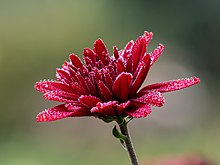This article needs additional citations for verification. (October 2015) |






Dew is water in the form of droplets that appears on thin, exposed objects in the morning or evening due to condensation.[1] As the exposed surface cools by radiating its heat, atmospheric moisture condenses at a rate greater than that at which it can evaporate, resulting in the formation of water droplets.[2]
When temperatures are low enough, dew takes the form of ice, called frost.
Because dew is related to the temperature of surfaces, in late summer it forms most easily on surfaces that are not warmed by conducted heat from deep ground, such as grass, leaves, railings, car roofs, and bridges.
- ^ "dew". Merriam-Webster.com Dictionary. Merriam-Webster.
- ^ "dew". The Columbia Encyclopedia (6th ed.). Retrieved 18 May 2013.